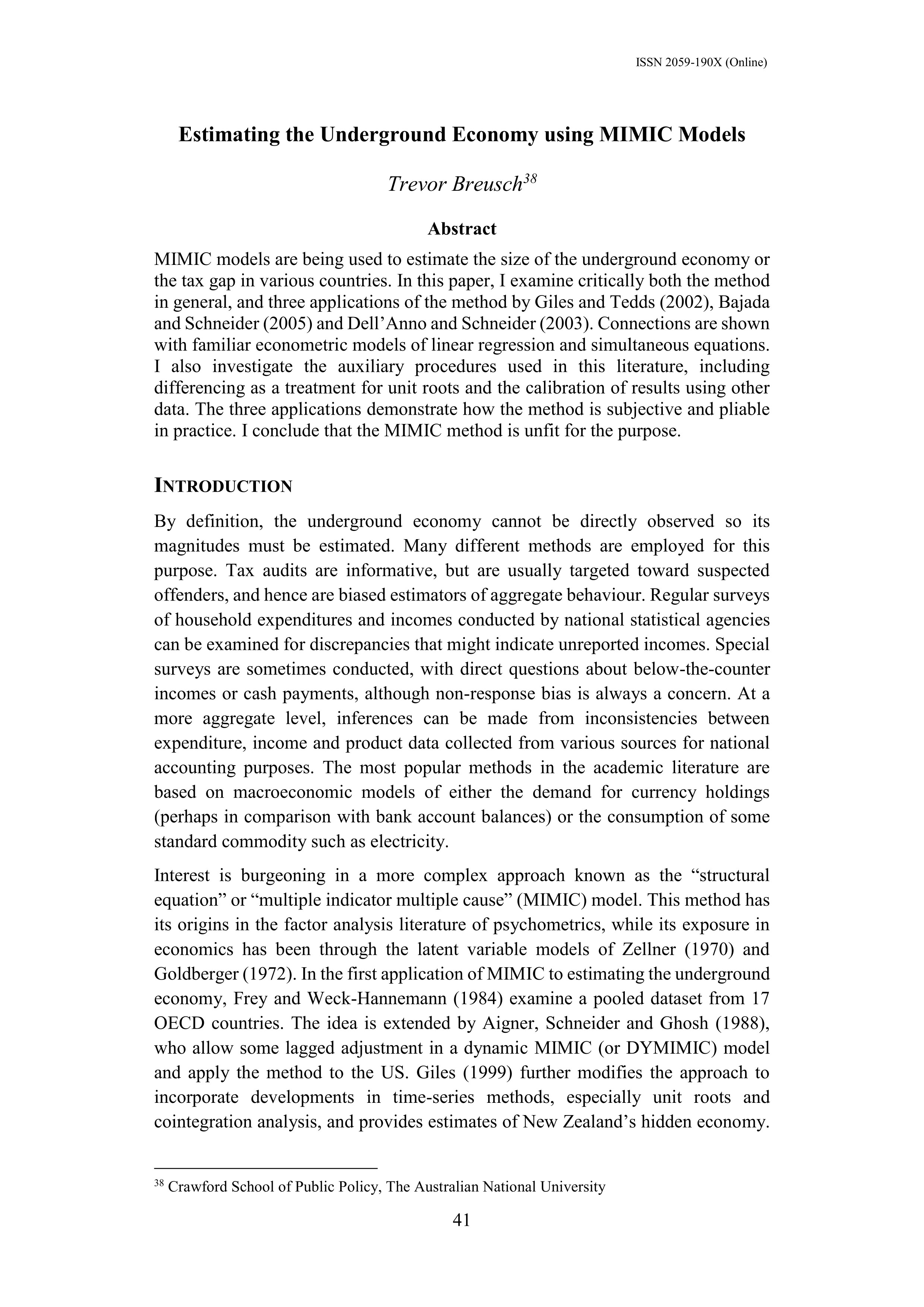Estimating the Underground Economy using MIMIC Models
Keywords:
Underground Economy, MIMIC, LISREL® Software, Structural ModellingAbstract
MIMIC models are being used to estimate the size of the underground economy or the tax gap in various countries. In this paper, I examine critically both the method in general, and three applications of the method by Giles and Tedds (2002), Bajada and Schneider (2005) and Dell’Anno and Schneider (2003). Connections are shown with familiar econometric models of linear regression and simultaneous equations. I also investigate the auxiliary procedures used in this literature, including differencing as a treatment for unit roots and the calibration of results using other data. The three applications demonstrate how the method is subjective and pliable in practice. I conclude that the MIMIC method is unfit for the purpose.
References
Aigner, D. J., Schneider, F., & Ghosh, D. (1988). Me and my shadow: Estimating the size of the US hidden economy from time series data. In W. A. Barnett, E. R. Berndt, & H. White (Eds), Dynamic Econometric Modelling (pp.224-243). Cambridge: Cambridge University Press.
Anderson, R. G., Greene, W. H., McCullough, B. D., & Vinod, H. D. (2008). The role of data/code archives in the future of economic research. Journal of Economic Methodology, 15(1), 99-119.
Bajada, C. (1999). Estimates of the underground economy in Australia. Economic Record, 75(231), 369-384.
Bajada, C., & Schneider, F. (2005). The shadow economies of the Asia-Pacific. Pacific Economic Review, 10(3), 379-401.
Breusch, T. (2005a). The Canadian underground economy: An examination of Giles and Tedds. Canadian Tax Journal, 53(2), 367-391.
Breusch, T. (2005b). Australia’s cash economy: Are the estimates credible? Economic Record, 81(255), 394-403.
Dell’Anno, R. (2003). Estimating the Shadow Economy in Italy: A Structural Equation Approach. Working Paper 2003-07, Institut for Økonomi, Aarhus University. Retrieved from ftp://ftp.econ.au.dk/afn/wp/03/wp03_07.pdf.
Dell’Anno, R., & Schneider, F. (2003). The shadow economy of Italy and other OECD countries: What do we know? Journal of Public Finance and Public Choice, 21(2-3), 97-120.
Dell’Anno, R., & Schneider, F. (2006). Estimating the Underground Economy by using MIMIC Models: A Response to T. Breusch’s Critique. Working Paper No. 067, Department of Economics, Johannes Kepler University of Linz. Retrieved from https://ideas.repec.org/p/jku/econwp/2006_07.html.
Frey, B. S., & Weck-Hannemann, H. (1984). The hidden economy as an “unobservable” variable. European Economic Review, 26, 33-53.
Giles, D. E. A. (1999). Modelling the hidden economy and the tax-gap in New Zealand. Empirical Economics, 24, 621-640.
Giles, D. E. A., & Tedds, L. M. (2002). Taxes and the Canadian Underground Economy. Toronto: Canadian Tax Foundation.
Goldberger, A. S. (1972). Structural Equation Methods in the Social Sciences. Amsterdam: North-Holland.
Hamilton, J. D., Zha, T., & Waggoner, D. F. (2007). Normalization in econometrics. Econometric Reviews, 26(2-4), 221-252.
Helberger, C., & Knepel, H. (1988). How big is the shadow economy? A re-analysis of the unobserved-variable approach of B.S. Frey and H. Weck-Hannemann. European Economic Review, 32, 965-976.
Hill, R. (2002). The underground economy in Canada: Boom or bust? Canadian Tax Journal, 50(5), 1641-1654.
Jöreskog, K. G., & Goldberger, A. S. (1975). Estimation of a model with multiple indicators and multiple causes of a single latent variable. Journal of the American Statistical Association, 70(351), 631-639.
McCullough, B. D., McGeary, K. A., & Harrison, T. D. (2006). Lessons from the JMCB Archive. Journal of Money, Credit and Banking, 38(4), 1093-1107.
Pagan, A. (1979). Some consequences of viewing LIML as an iterated Aitkin estimator. Economics Letters, 3, 369-372.
Schneider, F., & Enste, D. (2000). Shadow Economies around the World: Size, Causes, and Consequences? IMF Working Paper No.26, International Monetary Fund, Washington, DC.
Smith, R. S. (2002). The underground economy: Guidance for policy makers? Canadian Tax Journal, 50(5), 1655-1661.
Tedds, L. M., & Giles, D. E. A. (2005). Response to Breusch’s critique. Canadian Tax Journal, 53(2), 392-395.
Zellner, A. (1970). Estimation of regression relationships containing unobservable variables. International Economic Review, 11, 441-454.

Downloads
Published
How to Cite
Issue
Section
License
Copyright (c) 2016 Trevor Breusch

This work is licensed under a Creative Commons Attribution 4.0 International License.
Our open access status means that authors retain the copyright of their work. However, all papers published in JOTA are done so under a Creative Commons Attribution 4.0 International license (CC BY). This means that others can share and/or adapt your work without your permission as long as they follow certain rules, including attributing your work correctly.
You can learn more about this on our Open Access, Licensing, and Copyright Policies page.



